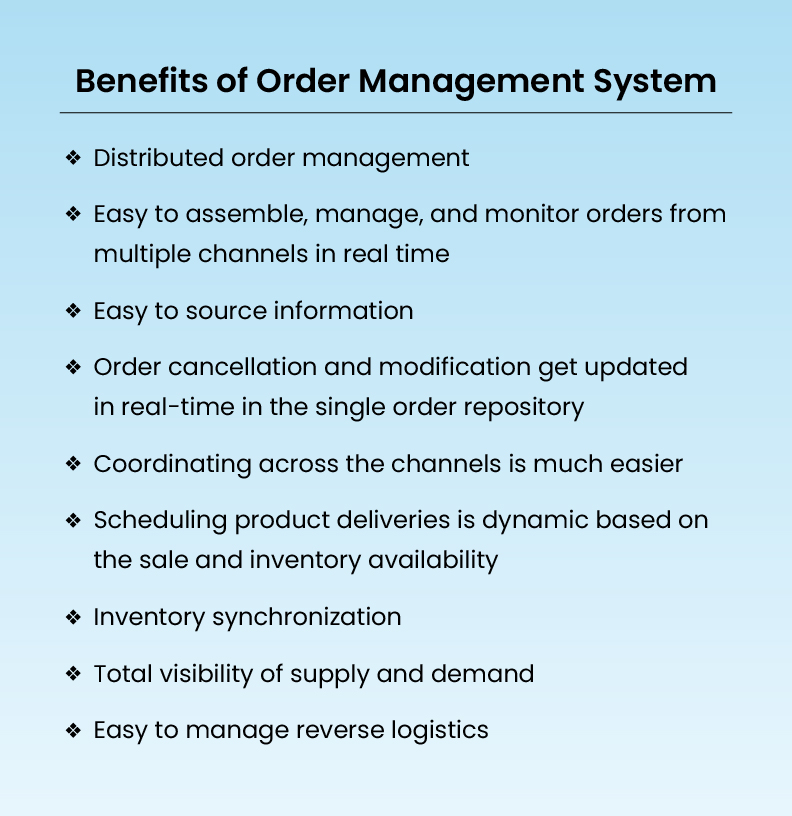Popular Posts
- Order Management
- TikTok Shop
- Temu
- About 4Seller
- Amazon
- Shopify
- Inventory Management
- Amazon MCF&FBA
- Amazon Shipping
- UPS
- FedEx
- DHL Express
- Listing Management
- Creator Bulk Invite
- GLS
- Seller Tips
- eBay
- Shein
- Marketplace News
- Royal Mail
- Amazon MCF
- Walmart
- Multi-channel Store
- Logistics Rule
- Shipping Integration
- Stripe Tracking Sync
- Poste Italiane
- UniUni
- USPS
- PayPal Tracking Sync
- OTTO
- Walmart WFS
- Yodel
- Kaufland
- BRT
- CaiNiao
- Chronopost
- CIRRO
- Correos
- Correos Express
- Deutsche Post
- DHL Parcel
- Etsy
- Evri
- GOFO
- Inventory Sync
- Beginner Tutorial
- DPD
- Shipping Label
- DHL
- FBM
- Platform Integration
- AliExpress
- 3PL
- Cdiscount
- OMS
- WooCommerce
Say Goodbye to Spreadsheets: Gain Control with Order Management Systems
 By Paul09 May,2024
By Paul09 May,2024
Order fulfillment involves multiple activities throughout the entire order life cycle. From the time a customer places an order until the order reaches the customer, there are various stages, and businesses may lose visibility and control. Accurate and timely information is critical to order fulfillment. Very often, accurate order information is not available when needed. Omni channel ecommerce companies managing orders manually through an Excel sheet suffer to aggregate orders from multiple order capture channels.
Moreover, administration and maintenance of customer databases, their past orders, predicted purchases, etc, is difficult while maintaining an Excel sheet. Order cancellation and modification take time to get updated in the manual entry on the Excel sheet. Such systems cannot simply function as a single repository. Order management systems or OMS can be the right investment for businesses to mitigate order management challenges.Spreadsheets are very commonly used, especially by small businesses since they are highly cost-effective. Although they are quite flexible and can be easily accessed across organizations, they have a number of drawbacks which are discussed below:
Drawbacks of Using Spreadsheets
Increased Risk of Errors
The data entered in a spreadsheet are prone to human errors. The probability of a mistake while copying or pasting is quite high when spreadsheets are used. Using the wrong formula can also lead to heavy mistakes in a spreadsheet. About 88% of all the spreadsheets have at least one error.
Minor mistakes during data entry can lead to major complications when dealing with complex business processes.
Time-Consuming
Maintaining and working on spreadsheets can be time-consuming, especially when a large amount of data is to be handled. Spreadsheets require manual efforts to enter data and manage it, which can take longer time.
Fails to Capture Real-time Inventory
Order management involves several processes which are usually handled by different departments. This can result in data silos and failure to capture the real-time inventory data. Data silos can lead to complications in handling orders.
Scalability Limitations
Spreadsheets might help manage orders for a small business. However, it lacks the scalability potential that is required to handle a large number of orders. Also, spreadsheets do not have the ability to manage orders with multichannel selling.
It is time to say goodbye to Excel sheets and hi to order management tools.
Order Management System
An order management system is a software solution that is developed to help businesses manage and track their orders throughout their lifecycle. It works to manage the processes, including order entry, order fulfillment, inventory management, and after-sales service.
With the rise in the number of businesses opting for multichannel selling, order management systems have gained immense popularity. Order management software allows businesses to manage order fulfillment processes efficiently across the entire supply chain network. Such process-based management across channels enables customized order fulfillment as per the defined business requirements. It seamlessly allows businesses to meet the customers' expectations.
Order management systems simplify the order management process with a number of benefits, a few of which are mentioned below:
Pros of Using OMS over Spreadsheets
Order management systems are not new to businesses. However, there are some businesses that still rely on spreadsheets for streamlining their order management. Check out the benefits that order management systems can provide for a business:
Here is a detailed explanation of the benefits of using the next-generation order management system:
01. Seamless Order Management with Centralized System
An order management system is a centralized system that can streamline all the business processes involved in order management. The implementation of OMS software helps the departments of an organization stay on the same page by eliminating data silos.
It helps businesses to operate in sync to improve overall efficiency, saving time that is required for data entry through human efforts. OMS can also reduce the risk of manual errors while recording data.
02. Real-time Inventory Updates
Since most of the order management systems are automated, stakeholders can have real-time inventory data updates.
Updates on inventory availability can be very beneficial for several processes right from production to sales. Real-time inventory updates can help make informed decisions.
03. Enhanced Customer Experience
The order management systems can do wonders to improve customer experience. An OMS offers customers the ability to track their orders and a chance to predict the arrival of their orders. Also, an order management system can help with the processes of exchanging or returning the products in case of dissatisfaction.
Customers love the transparency from a brand when they buy something and a great order management system can offer just that to their customers. The tracking of the orders right from the time they are placed to delivery and even after that greatly enhances the customer experience.
04. Improved Analytics
An order management system can be very beneficial in keeping data secure. Along with the customer information, these systems are equipped to even store historical data.
These systems can be leveraged to analyze data like best-selling products, target customers, target market, buying patterns, and the most-valued customers. Employing appropriate data analysis techniques to make data-driven decisions and help the business grow.
Conclusion
Owing to the competitive business landscape, order management systems have become a necessity for growing the business. Opting for an efficient OMS is a great way to streamline the most critical business processes.
While there are a number of vendors offering Order Management Software solutions, businesses can analyze their requirements and choose the best solution that suits their requirements.
To have an edge over their competitors, it is time to say goodbye to spreadsheets and adopt order management systems to gain control over their business processes.
If e-commerce business owners are looking for an omnichannel solution to manage their products, orders, and inventory, 4Seller is the right choice. 4Seller ERP is currently available at no cost and easy to use.
Author Bio:
Paul Wheelson
Paul Wheelson is a freelance writer, and a voracious reader. He likes writing about technological innovations, and evolvements. When he is not writing, he loves to travel and understand different cultures and origins.
Related Articles:Top 4 Best Shopify ERP Integration Solutions for 2024
How to Use Amazon MCF/FBA to Fulfill TikTok Shop Orders?
How to Set Up A TikTok Shop in USA 2024? (Step-By-Step)
Ultimate Guide to Find Winning Products on TikTok 2024(7 Tips)
Topics
All Topics
- Order Management
- TikTok Shop
- Temu
- About 4Seller
- Amazon
- Shopify
- Inventory Management
- Amazon MCF&FBA
- Amazon Shipping
- UPS
- FedEx
- DHL Express
- Listing Management
- Creator Bulk Invite
- GLS
- Seller Tips
- eBay
- Shein
- Marketplace News
- Royal Mail
- Amazon MCF
- Walmart
- Multi-channel Store
- Logistics Rule
- Shipping Integration
- Stripe Tracking Sync
- Poste Italiane
- UniUni
- USPS
- PayPal Tracking Sync
- OTTO
- Walmart WFS
- Yodel
- Kaufland
- BRT
- CaiNiao
- Chronopost
- CIRRO
- Correos
- Correos Express
- Deutsche Post
- DHL Parcel
- Etsy
- Evri
- GOFO
- Inventory Sync
- Beginner Tutorial
- DPD
- Shipping Label
- DHL
- FBM
- Platform Integration
- AliExpress
- 3PL
- Cdiscount
- OMS
- WooCommerce
Popular Posts
- 17 Dec,2024
Table of Content
Popular Posts
- 17 Dec,2024
Back to top





